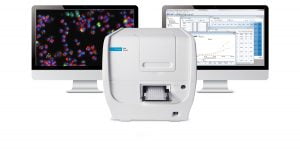In vitro assays are detrimental to determine cellular function. During my PhD studies I used many in vitro readouts for cellular function and metabolism of macrophages to find novel targets to treat chronic inflammatory disorders like atherosclerosis. The assays I used mostly involved 96-well based assays to quickly analyze changes in cell response upon several activators and inhibitors.
Before we acquired the Cytation 5 from BioSPX, we mostly quantified our readouts based on absorbance or by flow cytometry, but we could not quickly scan for visual changes or cell numbers in this 96-well format. As such, we did not normalize cytokine or NO secretion for cell counts and could only normalize metabolic flux analyses for protein or DNA abundance in the well.
Measurements from absorbance to fluorescent pictures


PhD Sanne Verberk
Department of Molecular Cell Biology and Immunology
Amsterdam UMC, VUmc